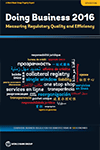Overview
The Doing Business indicators on trading across borders were among the first global measures of the administrative, regulatory and logistical burdens that add to the time and cost for trading internationally. This year’s report introduces important changes in the methodology for the indicators, which are aimed at increasing the economic and policy relevance of the indicators. The basic premise of the new methodology is that the case study should reflect the actual directions and volumes of international trade—and that the administrative and regulatory burdens faced by traders differ greatly across different traded products and trading partners. Under the new methodology, Doing Business measures the time and cost for three sets of procedures needed for exporting and importing: documentary compliance, border compliance and domestic transport. For the first time this year, Doing Business considers the product of comparative advantage for each economy when measuring export procedures, while for import procedures it focuses on a single, very common manufactured product (auto parts).
Main Findings
- Using a new methodology, Doing Business measures the time and cost for three sets of procedures needed for exporting and importing: documentary compliance, border compliance and domestic transport.
- For the first time this year, Doing Business considers the product of comparative advantage for each economy when measuring export procedures, while for import procedures it focuses on a single, very common manufactured product (auto parts).
- Among economies requiring product-specific inspections for their exported agricultural product, border compliance times range from 11 hours to 210. This variation suggests that it is possible to protect consumers and businesses without unduly delaying trade.
- For economies in a customs union with their case study trading partner, the time for documentary and border compliance is substantially lower on average than for others.
- Economies that are less efficient importers also tend to be less efficient exporters.

